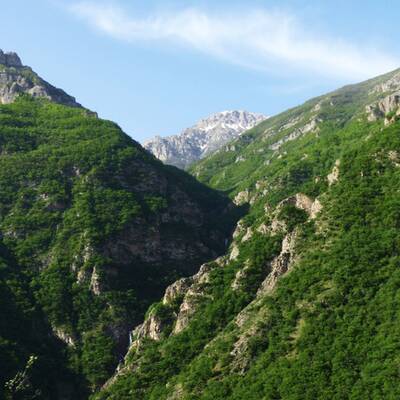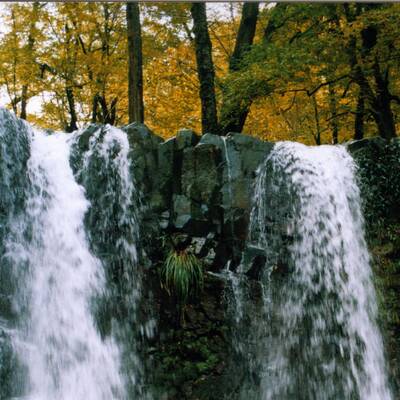Geography
Located between the Alborz Mountain Range, Talesh mountains, and the Caspian Sea, Gilan is a land where rivers cascade down from the mountains and lush forests captivate the eye.
History
Archaeological findings suggest that Gilan was home to 3,000-year-old civilizations such as Marlik and Amlash.
The name "Gilan" is a combination of "Gil" and "an", the latter being a suffix denoting location. Therefore, Gilan means "the land of the Gil people." The Gils are an Iranian ethnic group who speak the Gilaki dialect.
In the late Qajar period, Gilan was known as the "Gateway to Europe." The province has played a crucial role in Iran's contemporary history, with the Constitutional Revolution and the Jungle Movement led by Mirza Kuchak Khan being among the most influential events.
Climate
Gilan has a mild and humid climate. Talish mountains and the Alborz Mountain Range prevent moisture from the sea from reaching Mazandaran, resulting in high humidity levels in Gilan for most of the year. This high humidity moderates the climate, making severe frosts or extremely hot days rare. However, the moist air in the summer can lead to prolonged periods of muggy weather.
Cities
Gilan has 16 cities: Astara, Astaneh Ashrafieh, Amlash, Bandar-e Anzali, Talesh, Rasht, Rezvanshahr, Rudbar, Rudsar, Siahkal, Shaft, Sowme'eh Sara, Fuman, Lahijan, Langeroud, and Masal.
Rasht
Rasht is the capital of Gilan and the largest city in the province. The local pronunciation of the name is "Resht", which means "to rain." Rasht has an average annual rainfall of 1,359 millimeters, making it the provincial capital with the highest annual rainfall and earning it the nickname "the City of Silver Rains."
In 2015, Rasht was recognized as a UNESCO Creative City of Gastronomy due to its 220 local dishes and the diversity of its local food products.
Bandar-e Anzali
Bandar-e Anzali is the second most populous city in Gilan Province. Anzali has gained fame as the gateway to Europe due to its status as a port and its maritime connections with other cities around the world. In 2005, the Anzali Free Trade-Industrial Zone was introduced as one of the seven free trade zones in the country.
Anzali has a humid and rainy climate, making it the wettest city in Iran.
Anzali Lagoon, covering an area of about 20,000 hectares, hosts migratory birds every year, which come to this lagoon from Russia and neighboring northern regions of Iran to spend the winter. Sarakhan Lake is part of Anzali Lagoon and is the path to reach the blue water lilies.
Historical Ghazian Bridge, Clock Tower (Minaret of Anzali), Mirza Kuchak Khan Ship, Midship Palace Museum, Coastal Boulevard, Polish Cemetery, Hafeziyeh Building in Anzali, and Saturday Market are among the tourist attractions in Bandar-e Anzali.
Astara
Astara is the northernmost point of Gilan Province bordering the Republic of Azerbaijan. Astara is bordered by Rasht and Anzali on one side, Ardabil and Heyran Neck on the other. It also reaches the Republic of Azerbaijan and Baku.
Heyran Neck, Seashell Beach, Coastal Market, Stil Lagoon, Hot Springs of Kuteh Kumeh, and Laton Waterfall have made Astara a destination for many domestic and foreign tourists.
Talesh
Talesh is the name of one of the Iranian ethnic groups whose settlements begin from the Republic of Azerbaijan and continue to Gilan and Ardabil.
Talesh County is bordered by the high Talesh mountains on one side and a plain next to the sea on the other side, which has resulted in a climatic and vegetation diversity in this region.
Talesh ranks first in the country in sturgeon production. Tobacco, kiwifruit, Common medlar, and honey are important products of this city.
Gisoom Forest, Siah Daran Forest Park, Sled, Marjan and Agh Oular Highland, Subatan Highlands, Asalem-Khalkhal Road, and Visadar Waterfall have made Talesh a choice for many tourists in spring and summer.
Lahijan
There are different opinions about the naming of Lahijan; some say Lahijan is derived from Lahigan, which means weavers, Lahig in Persian means weaving, and it is the suffix of the location; therefore, Lahijan means the city of weavers and textile workers.
Another opinion suggests that "Lah" in Pahlavi means silk, and "jan" is the suffix of the location, so Lahijan means the city of silk.
Lahijan is famous for its tea gardens in Iran. During the Qajar period, a person named Kashef as-Saltaneh brought tea from India to Iran for the first time and saw the suitable climate of Lahijan for tea cultivation.
Lahijan's tourist attractions include Sheytan Koh Waterfall, Sustan Wetland, Mir Safa Forest Park, Sheikh Zahed Shrine, Chehr Padshah Shrine, Heshmati Bridge in Lahijan, Jame Mosque, Tea Museum, Akbariyeh Mosque, Golshan Bath, and Lahijan Swimming Pool.
Fuman
It has been said that Fuman is a remaining word from ancient Iranian language and is composed of two parts "Fo" or "Poo" and "Man." "Poo" or "Pooyi" means to take refuge in the Avestan language, and "Man" means to think; therefore, Fuman means the refuge of thinkers.
Fuman is known as the city of sculptures due to the many statutes existed there. Fuman has also many plane trees that give it a special charm. Masouleh stair-stepped village and Rudkhan Castle are among the attractions around Fuman.
Accommodations
Hotels such as Ordibehesht, Kadous, Pardis, and Pamchal in Rasht, Sefidkenar Hotel in Anzali, Mikal Accommodation in Mikal Village, Siahkal, Dilmaii in Tazehabad Jangah Village, Maryam Garden Cottage in Otaghvar, Punel Village Accommodation Complex, Lutka on the road from Anzali to Kiashahr are just a few of the many accommodations available in this province.
Local Foods
Due to its fish, olive, and various local vegetables, Gilan has a long list of special foods. The most important local foods in Gilan include Mirza Ghasemi, Baghla Ghatogh, Torsh-e Tareh, Anar Bij, Kalleh Kabab, Morgh Fesenjan or Morgh Lakou, Vavishka, Torshe Shami, Shish Andaz, Sir Abij, Sir Ghalieh, and Borani Bademjan.
Restaurants
If you're looking for a trendy and more contemporary restaurants, Razeghi, Grand, and Mess restaurants in Rasht are good options. If you want to try Gilan's local cuisine, don't miss Shurkouli, Mirza, and Gilehzan restaurants in Rasht.
Fans of kebabs and fish should definitely visit Dastak restaurant near Kiashahr. Ruben and Nazsara also serve grilled kebabs.
Parastoo Restaurant in Sowme'eh Sara, Saeed and Friends Kebab Restaurant in Anzali, and Ziba Restaurant in Lahijan also offer quality food to their customers.
Handicrafts
Each part of Gilan has its own special handicrafts; for example, pottery in Amlash, scarf weaving in Talesh, carpet weaving in Masouleh, and silk weaving in Lahijan are popular. Straw weaving and wooden handicrafts are other handicrafts of Gilan.
Souvenirs
The climate and weather of this region have led to the production of many agricultural and animal products. Tea, rice, Rudbar olives, various fresh and pickled fish, peanuts, citrus fruits, Fuman cookies, Reshteh khoshkar, and honey are souvenirs of this province.
Customs and Traditions
There are many customs in Gilan, especially in welcoming the New Year, which have gradually become less common and only continue to exist in rural areas.
One of the ceremonies in the last days of the year is called Noroozkhani, where people celebrate the arrival of spring. Before the start of spring, individuals known as Noroozkhan would walk down the streets and sing poems praising the beauty of spring.
Charshanbe Souri is one of those ceremonies held at the end of the last Tuesday of the year in all cities of the country. In Gilan, it is called Gool Gool Charshanbe in which they bring some straw, thorns, bushes, and logs into piles and set them on fire.
Lafandbazi, which is held during Nowruz and sometimes during religious holidays or local weekly markets, is similar to wrestling which is performed with four people. In this ceremony, people gather around to watch the match.

